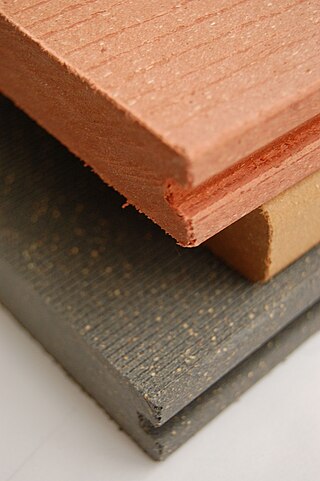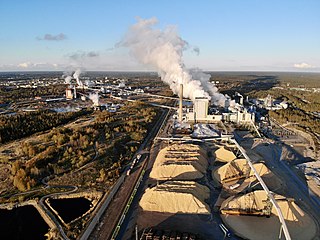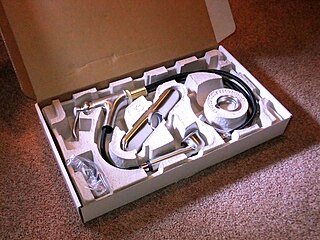Related Research Articles

Corrugated fiberboard or corrugated cardboard is a type of packaging material consisting of a fluted corrugated sheet and one or two flat linerboards. It is made on "flute lamination machines" or "corrugators" and is used for making corrugated boxes. The corrugated medium sheet and the linerboard(s) are made of kraft containerboard, a paperboard material usually over 0.25 millimetres (0.01 in) thick.

Papermaking is the manufacture of paper and cardboard, which are used widely for printing, writing, and packaging, among many other purposes. Today almost all paper is made using industrial machinery, while handmade paper survives as a specialized craft and a medium for artistic expression.

Pulp is a lignocellulosic fibrous material prepared by chemically or mechanically separating cellulose fibers from wood, fiber crops, waste paper, or rags. Mixed with water and other chemical or plant-based additives, pulp is the major raw material used in papermaking and the industrial production of other paper products.

UPM-Kymmene Oyj is a Finnish forest industry company. UPM-Kymmene was formed by the merger of Kymmene Corporation with Repola Oy and its subsidiary United Paper Mills Ltd in 1996. UPM consists of six business areas: UPM Fibres, UPM Energy, UPM Raflatac, UPM Specialty Papers, UPM Communication Papers and UPM Plywood. The Group employs around 17,000 people and it has production plants in 11 countries. UPM shares are listed on the NASDAQ OMX Helsinki stock exchange. UPM is the only paper company which is listed in the global Dow Jones Sustainability Index and also a member of the United Nations Global Compact organization.

Paperboard is a thick paper-based material. While there is no rigid differentiation between paper and paperboard, paperboard is generally thicker than paper and has certain superior attributes such as foldability and rigidity. According to ISO standards, paperboard is a paper with a grammage above 250 g/m2, but there are exceptions. Paperboard can be single- or multi-ply.

Wood-plastic composites (WPCs) are composite materials made of wood fiber/wood flour and thermoplastic(s) such as polythene (PE), polypropylene (PP), polyvinyl chloride (PVC), or polylactic acid (PLA).

The recycling of paper is the process by which waste paper is turned into new paper products. It has a number of important benefits: It saves waste paper from occupying homes of people and producing methane as it breaks down. Because paper fibre contains carbon, recycling keeps the carbon locked up for longer and out of the atmosphere. Around two-thirds of all paper products in the US are now recovered and recycled, although it does not all become new paper. After repeated processing the fibres become too short for the production of new paper, which is why virgin fibre is frequently added to the pulp recipe.

Tissue paper or simply tissue is a lightweight paper or, light crêpe paper. Tissue can be made from recycled paper pulp on a paper machine.

A paper bag is a bag made of paper, usually kraft paper. Paper bags can be made either with virgin or recycled fibres to meet customers’ demands. Paper bags are commonly used as shopping carrier bags and for packaging of some consumer goods. They carry a wide range of products from groceries, glass bottles, clothing, books, toiletries, electronics and various other goods and can also function as means of transport in day-to-day activities.

A pulp mill is a manufacturing facility that converts wood chips or other plant fiber sources into a thick fiber board which can be shipped to a paper mill for further processing. Pulp can be manufactured using mechanical, semi-chemical, or fully chemical methods. The finished product may be either bleached or non-bleached, depending on the customer requirements.

Molded pulp or molded fiber is a packaging material, that is typically made from recycled paperboard and/or newsprint. It is used for protective packaging or for food service trays and beverage carriers. Other typical uses are end caps, trays, plates, bowls and clamshell containers.

Paper is a thin sheet material produced by mechanically or chemically processing cellulose fibres derived from wood, rags, grasses, or other vegetable sources in water, draining the water through a fine mesh leaving the fibre evenly distributed on the surface, followed by pressing and drying. Although paper was originally made in single sheets by hand, almost all is now made on large machines—some making reels 10 metres wide, running at 2,000 metres per minute and up to 600,000 tonnes a year. It is a versatile material with many uses, including printing, painting, graphics, signage, design, packaging, decorating, writing, and cleaning. It may also be used as filter paper, wallpaper, book endpaper, conservation paper, laminated worktops, toilet tissue, currency, and security paper, or in a number of industrial and construction processes.

Vulcanized fibre or red fibre is a laminated plastic composed of only cellulose. The material is a tough, resilient, hornlike material that is lighter than aluminium, tougher than leather, and stiffer than most thermoplastics. The newer wood-laminating grade of vulcanized fibre is used to strengthen wood laminations used in skis, skateboards, support beams and as a sub-laminate under thin wood veneers.

Bamboo textile is any cloth, yarn or clothing made from bamboo fibres. While historically used only for structural elements, such as bustles and the ribs of corsets, in recent years different technologies have been developed that allow bamboo fibre to be used for a wide range of textile and fashion applications.
Deinking is the industrial process of removing printing ink from paperfibers of recycled paper to make deinked pulp.

The environmental effects of paper are significant, which has led to changes in industry and behaviour at both business and personal levels. With the use of modern technology such as the printing press and the highly mechanized harvesting of wood, disposable paper became a relatively cheap commodity, which led to a high level of consumption and waste. The rise in global environmental issues such as air and water pollution, climate change, overflowing landfills and clearcutting have all lead to increased government regulations. There is now a trend towards sustainability in the pulp and paper industry as it moves to reduce clear cutting, water use, greenhouse gas emissions, fossil fuel consumption and clean up its influence on local water supplies and air pollution.

Cellulose fibers are fibers made with ethers or esters of cellulose, which can be obtained from the bark, wood or leaves of plants, or from other plant-based material. In addition to cellulose, the fibers may also contain hemicellulose and lignin, with different percentages of these components altering the mechanical properties of the fibers.
In an era marked by a growing awareness of environmental issues, industries are continually seeking sustainable alternatives to traditional practices. One such innovation is wood-free paper, a game-changer in the world of printing and publishing. This revolutionary material offers a greener alternative to conventional paper production, making it an essential player in the pursuit of a more sustainable future. era marked by a growing awareness of environmental issues, industries are continually seeking sustainable alternatives to traditional practices. One such innovation is wood-free paper, a game-changer in the world of printing and publishing. This revolutionary material offers a greener alternative to conventional paper production, making it an essential player in the pursuit of a more sustainable future. Wood free paper production is not completely environmentally friendly.

A paper sack is a packaging type that can be constructed of one or several layers of high quality kraft paper, usually produced from virgin fibre. Paper sacks can also be referred to as industrial paper bags, industrial paper sacks or multi-wall paper bags or sacks. They are not to be confused with paper bags, the term which usually refers to paper carrier bags, or paper shopping bags.
Curran is a microcrystalline nanocellulose fibre derived from the pulp of root vegetables. It was developed by Scottish scientists David Hepworth and Eric Whale, with funding from the Scottish Government. The sources of root vegetable pulp used to manufacture Curran include carrots, sugar beets, and turnips. It is named after curran, the Scottish Gaelic word for "carrot". The material was developed as a potential substitute for carbon fibre and is often used in polymer composites. It has numerous industrial and technological applications, especially for the production of paints and sporting equipment.
References
- ↑ Philip Joseph Burton (2003). Towards Sustainable Management of the Boreal Forest. NRC Research Press. pp. 759–. ISBN 978-0-660-18762-4.
- ↑ Pratima Bajpai (21 November 2013). Recycling and Deinking of Recovered Paper. Elsevier Science. pp. 8–. ISBN 978-0-12-417169-5.
- ↑ Sustainable Building - Design Manual: sustainable building design practices. The Energy and Resources Institute (TERI). 1 January 2004. pp. 104–. ISBN 978-81-7993-053-3.
- ↑ Gericke, William F. (1940). The Complete Guide to Soilless Gardening (1st ed.). London: Putnam. pp. 38& 84. ISBN 9781163140499.
- ↑ Wallheimer, Brian (October 25, 2010). "Rice hulls a sustainable drainage option for greenhouse growers". Purdue University. Retrieved August 30, 2012.
- ↑ Caroline Baillie (8 March 2005). Green Composites: Polymer Composites and the Environment. CRC Press. pp. 94–. ISBN 978-0-8493-2576-2.